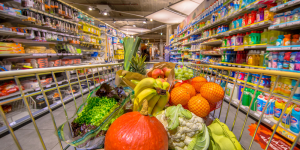How Grocery Prices Vary Across States: A Complete Guide to Smart Shopping in 2025
Analysis of CHOICE Survey Data 📊
Let’s dive into the nitty-gritty of why that loaf of bread or gallon of milk might cost more in one state compared to another.
A well-known consumer advocacy group, conducted an extensive survey comparing grocery prices across Australia’s states and territories.
The survey involved data collection from 104 supermarkets in 27 locations, offering a clear glimpse into the disparities in grocery costs throughout the country.
Despite the comprehensive data, there has been backlash from major supermarket players like Coles and Woolworths over the survey’s methodology.
They argue that the basket of 14 items, although carefully curated to mirror consumer habits, doesn’t always compare like-for-like products.
For instance, they highlight that the survey fails to directly compare their home brands against rivals like Aldi’s own brand products.

Impact of Aldi’s Presence 🛒
One factor that cannot be overlooked is the impact of Aldi’s presence on regional pricing dynamics.
Aldi, known for its competitive pricing, usually triggers a pricing competition among nearby supermarkets.
This means that areas with a significant Aldi presence tend to have lower overall grocery prices compared to places without an Aldi store.
Notably, states like Tasmania, which has limited Aldi stores, see comparatively higher grocery prices as indicated in the survey.
Coles and Woolworths counter claims by stating their home brand items are competitively priced and often cheaper but acknowledge that more remote regions could face pricing challenges due to logistics and other external factors like rent, fuel, and shipping costs.
Factors Contributing to Higher Prices in Remote Areas 🚚
Higher grocery prices in remote areas boil down to a mix of logistics, market dynamics, and limited competition.
Transporting goods to far-flung parts of the country adds substantial costs, which are passed on to consumers.
For instance, places like rural Victoria or remote parts of the Northern Territory typically experience higher prices due to these added logistical expenses.
Beyond transportation, these regions often have fewer competing retailers.
With less competition, the few available stores can maintain higher pricing structures.
Residents like Karel de Jong from regional Victoria find themselves driving long distances—sometimes nearly 95 kilometers—to shop at stores like Aldi to achieve significant savings on their grocery bills.
Understanding these regional variations is crucial for consumers trying to optimize their shopping budgets.
Whether it’s by evaluating home brands versus national brands or navigating the cost disparities driven by market competition and logistical challenges, knowing the factors at play can greatly empower buyers.
Major Supermarket Pricing Strategies 🏷️
When it comes to grocery shopping in Australia, understanding the pricing strategies of major supermarkets can help consumers make better choices.
Let’s explore how Coles and Woolworths compare with discount retailers, the debate over home brand versus national brand pricing, and how supermarkets respond to inflation.
Comparison of Coles and Woolworths Pricing with Discount Retailers 💵
Consumers often wonder whether they are getting the best deal when shopping at major supermarkets like Coles and Woolworths compared to discount retailers such as Aldi.
JP Morgan’s price check of 100 packaged grocery products revealed that Coles and Woolworths’ online prices could be significantly higher than Aldi prices in Sydney metro stores.
Woolworths and Coles frequently emphasize that their home brand items are priced competitively against Aldi’s.
For instance, Woolworths claims that their home brand products are on average 30 percent cheaper than national brands, aligning closely with Aldi’s pricing.
However, price comparisons are tricky.
Consumers like Bec Cocker in Adelaide cut their grocery bills from $300-$350 to $200 by shopping at Foodbank and Aldi, suggesting substantial savings outside traditional supermarkets.
Debate Over Home Brand vs. National Brand Pricing ⚖️
A central argument in the pricing battle is between home brand and national brand products.
Coles and Woolworths argue that CHOICE’s grocery basket survey, which includes both home and national brands, doesn’t compare like-for-like products.
They assert that when compared to Aldi’s home brand items, their prices are much closer.
However, maintains that their surveys reflect the real shopping habits of Australians, incorporating a mix of home and national brands to depict a true cost of groceries.
Supermarkets’ Response to Inflation and Price Monitoring 📈
Inflation heavily influences grocery prices, with factors like ingredient costs, rent, fuel, wages, and shipping playing significant roles.
Coles reported that their price inflation was just 1 percent in the first quarter of their financial year, considerably below the industry standard.
Woolworths, meanwhile, has noted decreases in average prices across its supermarkets over recent financial quarters.
Despite price monitoring efforts and some reductions, the anticipated overall drop in prices hasn’t materialized entirely.
Understanding the nuances of these pricing strategies is crucial for consumers aiming to get the best value for their money.
Economic factors and supermarket policies continue to shape grocery pricing in complex ways.
As consumers look for ways to adapt, some are shifting their shopping habits significantly.
Consumer Adaptation Strategies 🛍️
Shifting from Major Supermarkets 🚶♀️
With rising grocery prices, many consumers are rethinking their shopping habits.
Individuals, like Adelaide resident Bec Cocker, have moved away from major supermarkets such as Coles and Woolworths, toward discount retailers like Aldi and charitable organizations like Foodbank and Puddlejumpers.
By leveraging these resources, Bec has successfully reduced her grocery spending from $300-$350 to about $200 weekly.
This shift highlights a growing trend among shoppers to seek out and rely on more affordable and alternative sources for their grocery needs.
Long-Distance Shopping Trips 🛒🚗
| Details | Information |
|---|---|
| 🧑🦰 Shopper | Karel de Jong |
| 🌍 Location | Woosang, Victoria |
| 🚗 Distance Traveled | 95 kilometers to Bendigo |
| 📅 Frequency | Every 6-7 weeks |
| 💰 Cost of Trip | $400-$450 |
| 💸 Savings | $700 at local IGA (instead of $400-$450 at Aldi) |
Home Gardening and Bulk Buying Techniques 🌱
Many households are turning to home gardening and bulk buying to manage expenses.
Carl Higgs in Melbourne has taken to growing his own herbs and leafy greens while also baking his own bread weekly.
This method not only minimizes waste but also improves the quality of meals.
Carl also purchases essentials like toilet paper and olive oil in bulk, ensuring he maximizes savings while enjoying consistently high-quality products.
These adaptive strategies underscore the creativity and resilience of consumers in response to economic pressures.
As we progress, these practices will remain essential to influence how both individuals and communities manage their grocery expenses.
Moving into our next exploration, we’ll delve deeper into diverse cost-saving shopping methods that can further enhance budget efficiency.
Cost-Saving Shopping Methods 💡
Navigating the rising grocery prices requires a creative approach to saving money.
Whether it’s by making your own baked goods, strategically shopping across various stores, or buying in bulk, these methods can help ease the financial burden on the everyday shopper in 2025.
DIY Approaches: The Art of Home Baking and Gardening 🍞🌱
One way to cut down on grocery expenses is by embracing the do-it-yourself lifestyle.
Home baking is a rewarding activity that not only saves money but also fills your home with the captivating scent of freshly baked treats.
Take it a step further by growing your produce.
Fresh herbs, leafy greens, and even some fruits can thrive in a home garden, reducing the need to purchase these items at the store.
As Carl Higgs from Melbourne demonstrates, incorporating homebaked bread and garden-fresh ingredients into his meals offers an economical and fulfilling solution to high grocery costs.
Shopping Strategies: Scouting for the Best Prices 🛍️💸
Strategic shopping involves visiting various stores to find the best prices.
It might seem time-consuming, but the savings can be worthwhile.
Karel de Jong, who travels 95 kilometers to shop at Aldi every six to seven weeks, achieves significant savings by stocking up and freezing items for future use.
This method can be especially advantageous for those living in areas with limited shopping options, as demonstrated by Carl Higgs’ shift from major supermarkets to local fruit and vegetable stores offering cheaper and fresher produce.
Bulk Buying: Maximizing Savings Through Quantity 🏷️
Purchasing in bulk is another efficient approach to fight rising costs, especially for non-perishable items.
Bulk buying not only reduces the per-unit cost but also minimizes the frequency of trips to the store. Consider freezing items such as meats and bread to extend their shelf life.
By focusing on long-lasting essentials, you can effectively reduce your weekly grocery expenditure.
Karel de Jong’s approach of bulk buying and storing items in the freezer highlights how a single trip can last several weeks, turning a costly expense into manageable spending.
By integrating these cost-saving techniques into your shopping habits, you can cushion the financial impact of rising grocery costs.
These methods not only save money but foster a more conscious and deliberate approach to shopping, with an overarching impact on managing household budgets effectively.
Community Support and Resources 💖
In today’s challenging economic climate, the role of community support in offering grocery assistance has become crucial.
Food banks and charitable organizations are stepping up, providing much-needed relief and ensuring that families like Bec Cocker’s can manage their weekly grocery bills more effectively.
Role of Food Banks and Charitable Organizations 🏪
Food banks, such as Foodbank and local charities like Puddlejumpers, have been instrumental in helping households stretch their budgets.
These organizations provide access to discounted and sometimes free essential items, enabling families to divert scarce resources to other pressing needs.
For example, Bec Cocker, a mother of five, has significantly reduced her grocery expenses by relying on Foodbank for bulk purchases.
Without such services, she says affording groceries would be a major struggle.
Volunteer Initiatives and Community Support Programs 🙋♀️
Community-run programs not only offer food assistance but also foster a spirit of giving back.
Volunteer initiatives are crucial in the sustainability of these programs.
Inspired by her own experiences, Bec has volunteered at Puddlejumpers since 2024, and her journey highlights how volunteering can offer personal fulfillment and contribute to community resilience.
It’s not just about receiving help; it’s about becoming part of a support network that thrives on shared effort and kindness.
Transitioning from Recipient to Contributor 🌱
A unique aspect of these community initiatives is the transition many individuals make from being beneficiaries to active contributors.
As beneficiaries experience the immense value of community support, many feel motivated to give back, thereby sustaining the cycle of aid.
Bec’s experience of volunteering alongside her children is a testament to the empowerment that community involvement can foster.
It creates a sense of belonging and purpose, motivating others to come forward and share their time and abilities.
Though grocery prices continue to pose challenges, the strength of community ties provides a hopeful outlook.
Looking forward, even as grocery shopping dynamics continue to evolve, the community’s role in support and resilience remains invaluable.






